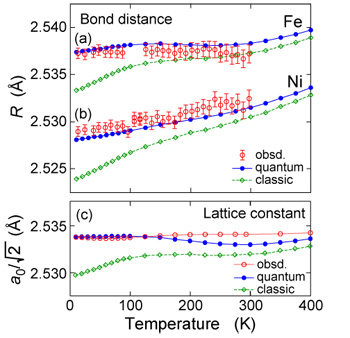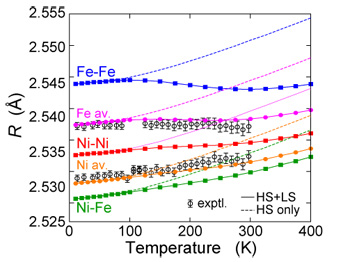
Toshihiko Yokoyama (Department of Materials Science, IMS) and his collaborator Keitaro Eguchi (Department of Structural Molecular Science, Sokendai) has revealed that the quantum fluctuation is essentially important to describe a long-standing problem of the thermal expansion of Invar alloy that exhibits anomalously small thermal expansion, by means of x-ray absorption fine structure spectroscopy measurements using synchrotron radiation and path integral computational simulations.
Since the discovery of Invar alloy Fe64.6Ni35.4 by C. E. Guillaume in 1897 [1] that shows anomalously small thermal expansion for the wide temperature range from extremely low to high temperatures, the origin of the Invar effect has been a long-standing problem. In 1963, R. J. Weiss [2] proposed a two-state model whereby Fe has two different electronic states of a stable high-spin (HS) state with a larger atomic radius and a less stable low-spin (LS) state with a smaller atomic radius. Upon a temperature rise, Fe is likely to have a LS state and to be contracted, leading to compensation for normal thermal expansion due to larger vibration at higher temperature. This Weiss model has been widely believed and is at least qualitatively appropriate. The quantum fluctuation should however be important to describe low-temperature vibrational property, while no attempt has been performed to explain the Invar effect using quantum mechanical molecular dynamics. In the present study, the importance of the quantum effect in the Invar alloy has been investigated. Fe and Ni K-edge extended x-ray-absorption fine-structure spectroscopic measurements and the computational simulations based on the path-integral effective-classical-potential theory [3] have been performed. Experimentally, the first nearest-neighbor shells around Fe show almost no thermal expansion [see Fig. 1(a)], while those around Ni exhibit meaningful but smaller expansion than that of fcc Ni [Fig. 1(b)]. At low temperature (<100 K), the quantum effect is found to play an essentially important role. This is confirmed by comparing the quantum mechanical simulations to the classical ones, the latter of which exhibit large (normal) thermal expansion at low temperature.
 Fig. 1: Thermal expansions of the nearest-neighbor shells around Fe (a) and Ni (b) and the lattice constant (c) determined by the experiment (o) and by the quantum mechanical (●) and classical simulations (◊). Almost no thermal expansion around Fe is seen (a), while that around Ni is clearly observed (b). The quantum mechanical simulations agree well with the experiment. On the contrary, the classical ones deviate significantly at low temperature (<100 K) and exhibit thermal expansion that would be expected in a normal material. The Invar effect at low temperature is concluded to originate from the quantum fluctuation.
Fig. 1: Thermal expansions of the nearest-neighbor shells around Fe (a) and Ni (b) and the lattice constant (c) determined by the experiment (o) and by the quantum mechanical (●) and classical simulations (◊). Almost no thermal expansion around Fe is seen (a), while that around Ni is clearly observed (b). The quantum mechanical simulations agree well with the experiment. On the contrary, the classical ones deviate significantly at low temperature (<100 K) and exhibit thermal expansion that would be expected in a normal material. The Invar effect at low temperature is concluded to originate from the quantum fluctuation.
It is also revealed that thermal expansion for the Ni-Ni and Ni-Fe pairs is noticeably suppressed [Fig. 2], even though the Ni electronic state may not vary depending on the temperature. Moreover, the suppression of the thermal expansion in the Ni-Ni pair is interestingly more significant than that in the Ni-Fe pair. This originates from the fact that Fe is likely to Fig. 2

Fig. 2: Thermal expansions of the nearest-neighbor Fe-Fe (blue), Ni-Fe (green), Ni-Ni (red), averages around Fe (pink) and Ni (orange), together with the experimental data (open circles with error bars). The dashed lines are the hypothetical normal thermal expansions that were estimated by the simulations assuming only the high-spin state in Fe. The Ni-Fe and Ni-Ni as well as Fe-Fe shells show much smaller thermal expansion than the corresponding hypothetical normal ones.
References
[1] C. E. Guillaume, CR Acad. Sci. 125, 235 (1897).
[2] R. J. Weiss, Proc. R. Soc. Lond. A 82, 281 (1963).
[3] A. Cuccoli, R. Giachetti, V. Tognetti, R. Vaia, and P. Verrucchi, J. Phys.: Condens. Matter 7, 7891 (1995); T. Yokoyama, Phys. Rev. B 57, 3423 (1998).
Journal Information
Journal:Physical Review Letters (Published online: 3 August 2011)
Title:Anharmonicity and Quantum Effects in Thermal Expansion of Invar Alloy
Authores:Toshihiko YOKOYAMA, Keitaro EGUCHI
http://prl.aps.org/abstract/PRL/v107/i6/e065901
YOKOYAMA Group Information
http://www.ims.ac.jp/english/know_en/materials/yokoyama/yokoyama_en.html
1113


